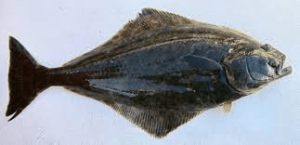
Pink salmon (Oncorhynchus gorbuscha) are also sometimes known as humpback salmon, or “humpies,” due to the hump males develop on their backs before they spawn. Pink salmon are the smallest of the five species of Pacific salmon found in Alaska. They average between 3.5 and 5 lbs. (1.6-2.3 kg) in weight and are usually between 20 and 25 inches (51-63 cm) long.
Young pink salmon are completely silver with no parr marks or spots. In their ocean phase, adult pink salmon are steel blue to blue green on the back and have silver sides and a white belly. As they get closer to fresh water, males develop large, black spots on the back, the adipose fin, and on both lobes of the caudal fin (tail). When they return to fresh water to spawn, males turn dark on the back and are red with olive blotches on the sides. They have a bright white belly. Females are similarly but less-distinctly colored. In their ocean phase, pink salmon have an elongate, fusiform shape, but when a male returns to fresh water, he develops a large hump on his back, an enlarged head with big teeth, and hooked jaws called a kype. These morphological changes allow a male to fight off other males once he has chosen a breeding partner.

Pink salmon are the most numerous Pacific salmon. They occur naturally throughout the coastal waters of the North Pacific Ocean, Arctic Ocean and nearby seas. In North America, pink salmon have been found in small numbers as far south as north-central California, but they are more common from Puget Sound northward. They also occur to the west from the Lena River in Siberia south to Korea and Kyushu, Japan. Pink salmon have been introduced to the Great Lakes. In Alaska, pink salmon are abundant along the coast.
Pink salmon complete their entire life cycle within two years, the shortest life cycle of any Pacific salmon. Because the life span is two years, fish born in an odd-numbered year do not interbreed with fish born in an even-numbered year, creating genetically distinct odd-year and even-year populations. Even if salmon spawn in the same stream, odd-year and even-year fish will never interbreed, and often, either the odd-year or even-year population in a stream will produce more fish.
Salmon eggs incubate in the gravel of a stream over the winter and hatch either in the late winter or early spring. The alevin that emerges from the egg remains under the gravel, receiving nutrients from the large yolk sac attached to its belly. Once it depletes its yolk sac and emerges from the gravel, the fry swims downstream to the ocean and begins eating plankton and larval fishes.
Eighteen months later, the adult salmon returns to the stream or river where it was born to spawn. It arrives back at the stream sometime between late June and mid-October, depending on the stream and the population. Once they reach their spawning stream, both males and females stop eating, and they change from their sleek, silver marine phase to their spawning coloration and morphology. A male develops hooked jaws and a hump on his back, and his head and teeth enlarge.
A spawning female chooses a suitable nesting spot in the gravel and prepares a nest by turning on her side, pressing her tail against the stream bottom, and giving several vigorous flaps with her tail. She repeats this action several times to dig a shallow hole. She then settles into the hole to deposit her eggs, and her male partner joins her to fertilize them, using his hooked jaw and large teeth to fend off any other would-be suitors. A female may dig as many as four nests. She digs the second nest upstream from the first nest, covering the eggs in the first nest with the gravel she dislodges while digging the second nest. A group of nests is called a redd. The female defends her redd until she dies, usually two weeks after spawning. All pink salmon die after they spawn.

A female pink salmon lays between 1200 and 1900 eggs. Pink salmon have a tough life. If a fry is lucky enough to make it downstream to the ocean, it faces a mortality rate of 2% to 4% per day for the first forty days. Young salmon provide food for birds, fish, invertebrates, and other predators. Studies show after forty days, the mortality rate drops to .4% to .8% per day. Once a salmon heads back to coastal waters and its natal stream, it must avoid humans, sharks, killer whales, seals, sea lions, river otters, eagles, and every fish larger than it is. When it reaches its birth stream, it becomes prey for bears, eagles, human anglers, and other predators.
Pink salmon mostly spawn in small streams and rivers near the coast, and most do not travel more than forty miles upstream to spawn. In large river systems, though, they sometimes travel further. Pink salmon have been documented swimming 130 miles (209 km) up the Susitna River in Southcentral Alaska, and they have been seen spawning 250 miles (402 km) up the Mulchatna River.
In the ocean, pink salmon eat plankton, small fish, squid, and an occasional aquatic insect. Their flesh gains its pink color from the tiny marine crustaceans they eat.
_________________________________________________________________________
Next week, I’ll write about the commercial and sports fisheries for pink salmon. While pink salmon may be the least flashy of the salmon species, they are known as the bread and butter of the salmon commercial fishing industry.
I will soon be releasing my next novel, The Fisherman’s Daughter, so check back often for updates on its release. Also, be sure to sign up for my monthly mystery newsletter. Newsletter subscribers will be the first to hear about the release of my new novel.

















